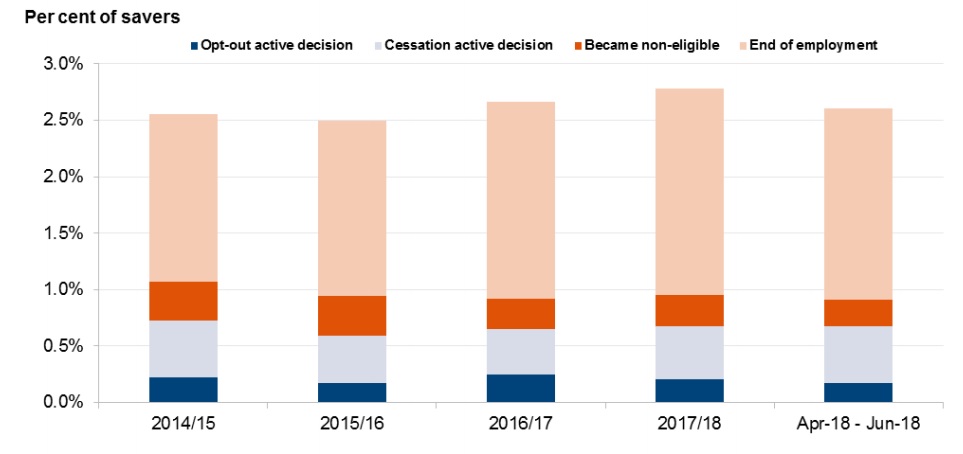Auto-enrolment savers have proved indifferent to a rise in their contribution rates imposed earlier this year, according to research, but the government remains unconvinced by the case for using inertia to tackle low self-employed saving rates.
The overall number of people leaving an employer’s auto-enrolment pension scheme dropped slightly in the months following the April employee contribution hike, to just over 2.5 per cent.
The majority of exits continue to come about because an employee ceases their employment or becomes ineligible.
In April 2019 we’ve got the tax allowance rise, so people get a take-home pay boost on top – so I think that gives us real hope
Steve Webb, Royal London
Opt-out rates (where employees stop saving within six weeks of enrolment) and cessations (when they stop saving outside of the six-week opt-out window) have fluctuated slightly from year to year, but in total remain comfortably below 1 per cent of employees, according to the government’s real-time information.
Pension providers said the government’s figures were consistent with their broad experience, marking a significant success for the auto-enrolment policy.
AE policy notches win
Steve Webb, Royal London’s director of policy, said the news confirmed predictions that Britain would take auto-enrolment increases “in its stride”.
Flatlining exit rates bode well for the future increase to 5 per cent employee and 3 per cent employer contributions, planned for April 2019 and potentially dampened by a rise in the income tax threshold to £12,500.

Source: DWP
“In April 2019 we’ve got the tax allowance rise, so people get a take-home pay boost on top – so I think that gives us real hope,” he said.
Next policy steps could include taking firm action on the government’s as-yet soft commitment to calculate contributions based on total earnings rather than a band, the former pensions minister added, and raising employer contributions to a matching 5 per cent in the coming years would soften the blow to employee disposable income.
Further hikes could be trickier
Nonetheless, the move to 5 per cent employee contributions will be a significant one.
Kate Smith, head of pensions at Aegon, said many savers in the insurer’s book already paid above minimum levels when the floor was lifted to 3 per cent.
In contrast, she said that “very few employees will pay above 5 per cent even with the tax relief”, with the result that savers could “notice a substantial change”.
Policymakers will be unconcerned that older workers, who may prefer to continue with their existing plans for retirement provision rather than begin contributing to a new scheme, were more likely to quit pension saving.
But opt-out rates were also higher for higher earners, even at salary levels where the limits on annual and lifetime contributions would be unlikely to have much impact.
“This is something that the government needs to try and understand more about,” said Smith, explaining that higher earners will receive less support from the state in reaching an adequate replacement rate in retirement.
Marketing will target self-employed
If the overarching assessment of auto-enrolment is that it has been a successful policy so far, the government has not been tempted to use the same behavioural drivers on the self-employed, a cohort who are reluctant to save into pensions.
In a separate paper the Department for Work and Pensions confirmed its commitment to industry-led trial interventions aimed at increasing self-employed saving.
Several trials will investigate self-employed behaviour, and whether better marketing and improving the ease of paying into a pension will improve average retirement preparation. A joint project involving Nest Insight, Smart Pension, Aegon and the Association of Independent Professionals and the Self-Employed, will develop a holistic savings solution to complement traditional pensions.
Unlike auto-enrolment policy, the trials will mostly seek to “create action rather than rely on inaction”, according to Steven Cameron, Smith’s colleague and pensions director at Aegon.
However, some self-employed will find themselves defaulted into saving. Those working with a single contractor could find themselves reclassified as workers and auto-enrolled, he said, while there is the potential to have exiting employees begin saving with their former employer’s chosen provider, after a grace period to allow for set-up costs.
“There might be this sort of default building on auto-enrolment that might work for certain segments,” he said, but cautioned that some cohorts of self-employed people do not like the idea of automation forcing their behaviour.
For more ardent champions of inertia, however, this policy direction misses an open goal.
“There’s nothing wrong with what they are proposing, it’s just not up to the scale of the problem,” said Webb. “We could have marketed employee pensions for 50 years and we wouldn’t have got the traction we got with auto-enrolment.”
Webb said he was unconcerned by higher opt-out rates among self-employed people, adding that even getting two-thirds of self-employed people saving would be “a triumph”.






















